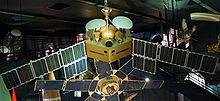Symphony (satellite)

Symphony was the name of a Franco-German communications satellite project . The name can be translated with consonance and should express the absolutely equal cooperation between the then West Germany and France .
Two satellites with this name were built. The satellites were stabilized with a spin wheel and correction engines. Its main body is in the shape of a hexagonal prism , and its three fold-out solar cell arms are offset from one another by 120 °. The solar cell booms were rigidly attached to the satellite and were therefore illuminated one after the other from both sides during one orbit around the earth. They therefore had solar cells on both sides.
Each satellite has two parabolic antennas for data transmission in a western and / or an eastern footprint and a smaller horn antenna for receiving the data from the visible third of the earth. Each satellite had two transponders with 90 MHz bandwidth on board. The ground station could choose via radio command which of the two parabolic antennas should transmit a transponder (it was also possible to select both transponders via a transmitting antenna). They could each broadcast one television program and 132 telephone channels. The symphony satellites were the most technologically advanced communications satellites of their time.
The start was originally planned with the failed European missile. Eventually they were launched from Cape Canaveral with two Delta 2914 missiles . However, the US government stipulated that the satellites would only be used for test purposes and not operationally, as they wanted to protect their own monopoly for communications satellites. These unacceptable conditions for future satellites led to the development of Ariane 1 .
Because of US restrictions on commercial use, the satellites were used for educational television and humanitarian missions. This included in particular educational television in India and Africa, broadcasts for Deutsche Welle, disaster relief operations by the Red Cross and peace missions for the United Nations.
The network of ground stations reached the number of over 50 stations worldwide in about 40 countries from Argentina to Africa, the Middle East and India to China.
- Symphony 1 weighed 230 kg and on December 19, 1974 at 2:39 a.m. UTC was the first Western European communications satellite to be brought into geostationary orbit by a Delta 2914 launch vehicle and positioned at 11.5 ° West. In 1977, Symphony 1 was moved to 49 ° East, where it stayed for two years before returning to its old position.
- Symphony 2 followed on August 27, 1975 at 1:42 UTC and was also stationed at 11.5 ° West, where it remained until it was decommissioned.
The lifespan of the satellites was designed for 5 years; the actually achieved mission duration was exactly 10 years. Symphony 2 was switched off on December 19, 1984 by the DLR space control center ( GSOC in Oberpfaffenhofen ) after it had been brought out of its geostationary orbit with a de-orbiting maneuver.
literature
- Niklas Reinke: History of the German space policy. Concepts, influencing factors and interdependencies: 1923-2002 , Munich 2004, ISBN 3-486-56842-6
- Manual dictionary of electrical telecommunications , 2nd edition, 3rd volume Q-Z; Pp. 1625-1626
Web links
- DLR: Symphonie Satellites ( Memento of February 28, 2011 in the Internet Archive )
- Gunter's Space Page: Symphony 1, 2 (English)
Individual evidence
- ^ Hans-Martin Fischer: European news satellites, From Intelsat to TV-Sat . Stedinger, Lemwerder 2006, ISBN 3-927697-44-3 , p. 48.
- ^ Hans-Martin Fischer: European news satellites. From Intelsat to TV-Sat . Stedinger, Lemwerder 2006, ISBN 3-927697-44-3 .
